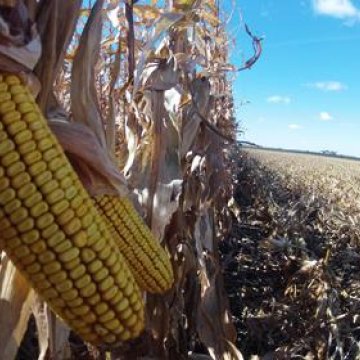Manage Delayed Planted Corn At Harvest

Corn maturity may be delayed by late planting and/or below normal summer temperatures. When slow corn development continues into the fall, corn grain may be significantly wetter at harvest. This can result in higher drying costs, mechanical damage to grain, and if a killing frost occurs before corn reaches maturity, yield reductions.
Planting Delays
Because GDU accumulation in early to mid-May is like GDU accumulation in late September when corn is maturing, each day of planting delay could result in a commensurate 1-day delay in maturity. However, corn can adjust to late planting by reducing its total GDU requirement slightly, by about 5 GDUs for each day planting is delayed beyond May 1. This means that corn maturity is usually delayed by only about 1 day for each 1.5 days of planting delay.
A Cool and Cloudy Summer
“Cool” or “moderate” summer temperatures are rarely more than 1 or 2 degrees below normal when considering the entire summer period. Such conditions would result in a deficit of 90 to 180 GDUs that has to be made up in late summer/early fall. This would result in about a 1- to 2-week delay in corn maturity in the central Corn Belt, and up to 3 weeks in northern corn-growing areas.
Kernel Drydown
The period from black layer to harvest is defined as the "drydown" period. Kernel moisture loss during the drydown period is entirely due to evaporative moisture loss affected by air temperature, relative humidity and wind. When corn reaches maturity late in the season, field drydown is slower due to cooler air temperatures. For example, according to Ohio State University Extension, corn drying rates of 1% per day in September will usually drop to 1/2% to 3/4% by early to mid-October 1/4% to 1/2% per day by late October to early November, and only 1/4% or less by mid-November (Thomison, 2011).
Corteva Agriscience™ research indicates that it takes approximately 15 to 20 GDUs to lower grain moisture each point from 30% down to 25%, 20 to 25 GDUs per point of drydown from 25% to 22%, and 25 to 30 GDUs per point from 22% to 20% (Corteva Agriscience™, unpublished). If a hard freeze occurs that stops corn development prior to maturity, these field drying rates may be affected. For example, corn frosted as early as the dough stage may require 4 to 9 extra days to reach the same harvest moisture as corn not frosted (Maier and Parsons, 1996).
Grain moisture at harvest affects the time and cost required to dry the grain to acceptable storage moisture levels, as well as grain quality. Wet grain can incur damage during combining, handling and drying. If grain quality is significantly reduced during harvest and drying, allowable storage time is also reduced, dockage may result, and losses of fines and broken kernels can trim bushels of saleable grain.
Preharvest Tips
In seasons with delayed corn crop development, many growers will have to deal with wetter than normal grain at harvest. Several steps can be taken prior to harvest to make this job go more smoothly (Lauer 2009).
If you have recorded silking dates by field, use these notes to predict the order in which fields will reach black layer and harvestable moisture. This will help in setting up a harvest schedule. However, be sure to base the schedule on crop condition as well as grain moisture, considering stalk quality and insect or disease damage.
Where such options exist locally, consider harvesting (or selling) more of your crop as silage or high moisture corn.
Explore locking in a price for the additional fuel needed for grain drying. Compare the fuel costs vs. possible dockage for shrink if wet corn is delivered to the elevator.
Consider some field drying if grain moisture levels are high, but don’t wait too long! Wet field conditions can keep combines out of the field as crops deteriorate, and snow and ice may increase harvest losses due to ear droppage and stalk breakage.
Managing Wet/Immature Corn
Combine Adjustments: Grain above 30% moisture can be difficult to remove from the cob and is easily cracked and damaged by overthreshing in the cylinder or rotor of the combine. Cylinder/rotor speed and concave clearance are the adjustments most critical to reduce grain damage and threshing losses. At high grain moisture growers may have to strike a balance between damaged grain and higher than normal grain loss from unshelled cobs.
With very wet grain, some ag engineers suggest beginning harvest with combine settings that would likely underthresh a typical, lower moisture crop (Brook and Harrigan, 1997):
- Set cylinder/rotor speed near the low end of the suggested range.
- Set concave clearance near the widest recommended setting.
- Open the chaffer and sieve to the maximum recommended openings.
- Check with the combine manufacturer for machine-specific recommendations. (Combine mechanics or other dealership staff are often a good source for this information).
- Begin with above settings but check immediately and readjust as necessary to achieve best results. Continue to check and readjust as crop conditions change.
Drying Wet/Immature Corn
Properly drying very wet, lower quality corn is essential to avoid further quality reductions. Growers should screen lower quality grain prior to drying, using a rotary screen, gravity screen or perforated auger housing section. This will help prevent foreign material and broken kernel fragments (or "fines") from blocking air flow essential to uniform grain drying and storage. Next, growers should plan to dry lower quality grain 1 or 2 points lower than the normal 14% to 15% often recommended for long-term storage. This is because of greater variations of moisture content within the grain mass and increased physical kernel damage and broken cobs, which could magnify mold problems.
According to extension specialists at North Dakota State University, energy efficiency is increased at maximum temperatures in high temperature drying systems, but these temperatures could scorch very wet or immature kernels. In addition, high temperature drying causes stress cracks in the kernel, which allows more breakage during handling and storage. The amount of stress cracking depends on initial grain moisture, rate of moisture removal, maximum grain temperature reached in the dryer, and rate of grain cooling. Therefore, drying temperatures need to be limited on corn of 25% to 30% moisture content (or higher).
With natural-air or low-temperature drying systems it will be difficult to adequately dry corn wetter than 26% grain moisture. The maximum moisture content for natural air drying of corn is 21% using an airflow rate of at least 1 cubic foot per minute per bushel of corn (Hellevang, 2009).
The University of Wisconsin gives these additional grain drying tips (Lauer, 2009):
- Fine-tune your dryer so that over- or underdrying does not occur. Overheating the grain in the dryer or filling the bin too fast for drying to occur will increase costs and decrease grain quality, thus reducing profitability.
- Hire and train the skilled labor that will be required to monitor dryers, fans, augers, and other equipment during the drying process.
To reduce drying time and speed harvest, some growers have discussed partially drying and aerating corn while holding it for further drying after completion of harvest. This strategy requires skill and intensive management, especially with low-quality grain.
Storing Wet/Immature Corn
Low test weight, lower quality grain is harder to store because it is breakage-prone and subject to mold and "hot spot" occurrence in the bin. Because the storage life of this grain may be only half that of normal corn at the same moisture content, consider selling this grain early rather than storing long term.
To minimize storage problems, begin by screen-cleaning grain before binning to remove as much of the fine material, cob pieces and broken kernels as possible. After filling, "core" the bin (remove up to 10% of the total bin capacity) to eliminate broken kernels and fines that accumulate in the center. Next, level the grain in the bin to minimize moisture accumulation at the top of the grain. Finally, cool grain as soon as it is dry to within 10 degrees of air temperature and continue to aerate for 10 to 14 days to ensure grain moisture "equilibrium" has been achieved.
Monitoring lower quality grain on a twice-monthly basis is essential to ensure that grain condition is maintained.
Harvesting wet/immature corn can be frustrating and hard. Follow your experience and a few of these tips to help you manage through this situation. Harvest is a long but rewarding time of year, work steady and slow, but most importantly be safe. As always, please reach out to your Hoegemeyer agronomist with any questions.
Sources
- Brook, R. and T. Harrigan, 1997. Harvesting and handling high moisture, frost-damaged grain. Harvest Alert Fact Sheet #5. Field Crops Team, Michigan State University.
- Hellevang, K. 2009. NDSU Extension Service to provide corn drying information at Big Iron. North Dakota State University Extension Service News Release.
- Lauer, J. 2004. Guidelines for handling corn damaged by frost prior to grain maturity. In Issues in Agriculture. University of Wisconsin Extension.
- Lauer, J. 2009. Will corn mature in 2009? Agronomy Advice – Field Crops 28:491-70. University of Wisconsin Extension.
- Maier, D. and Parsons, S. 1996. Harvesting, drying, and storing frost-damaged corn and soybeans. Grain Quality Task Force Fact Sheet #27. Purdue University.
- Thomison, P. 2011. Corn drydown: what to expect? Crop Observation and Recommendation Newsletter 2011:34. Ohio State University Extension.
- Steve Butzen, Agronomy Information Consultant, Pioneer, Johnston, Iowa.

